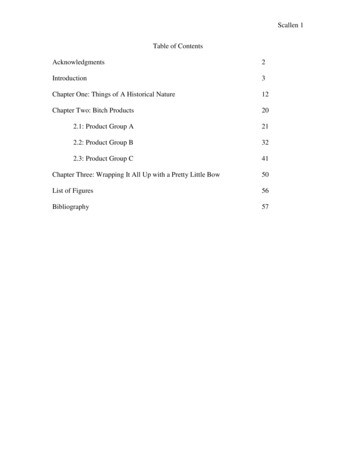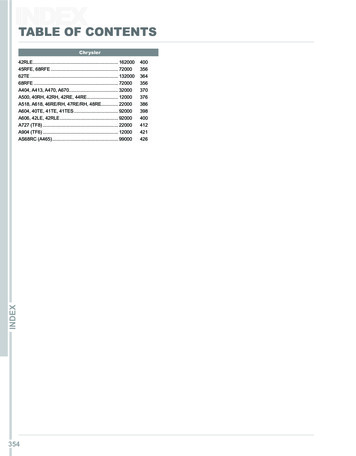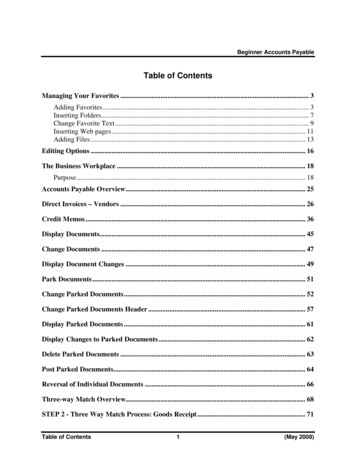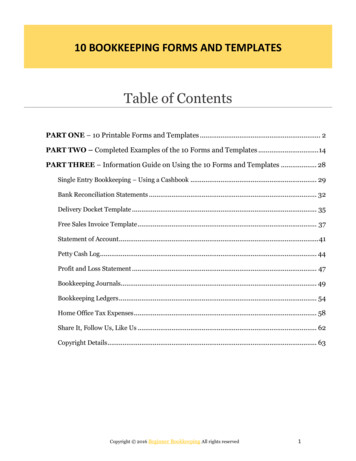
Transcription
Scallen 1Table of ContentsAcknowledgments2Introduction3Chapter One: Things of A Historical Nature12Chapter Two: Bitch Products202.1: Product Group A212.2: Product Group B322.3: Product Group C41Chapter Three: Wrapping It All Up with a Pretty Little Bow50List of Figures56Bibliography57
Scallen 2AcknowledgmentsSo, so many thank you-s are due. First and foremost, to dearest Mom, withoutwhom this thesis would be horrendously un-edited and ridiculously grammaticallychallenged. Thank you for your patience and understanding when drafts were sent in thewee hours of the morning, and needed to be sent back mere hours later. You’re a star.To Professor Doss, many, many thanks for the last minute meetings and youruncanny ability to “slash and burn” unnecessary words, sentences, and paragraphs. A truegift.To Professor Butler, many thanks for sharing with me invaluable resources andguidance in the world of academic feminism. Your support and suggestions helped makethis thesis what it is, and I cannot thank you enough for your patience andunderstanding especially when I missed class to work on The Thesis.A big thank you to the staff of Bitch: A Feminist Response to Pop Culture forallowing me to sit on a staff meeting, and for putting up with yet another inquiry into thedecision behind naming your magazine Bitch!Many thanks to the UROP program for providing me with the means to visit theBitch offices, and to Emily and Kate for providing me with the full hippie/hipsterimmersion experience in Oregon. Priceless.Finally, a HUGE thank you to the countless friends who have listened to myendless chatter about Bitches and shit, most especially dear, dear Anna and Paige.Without you, I would not have survived the Bitch Thesis unscathed. You da best. Andlastly, to Robyn, thank you for sharing the Thesis Cart of Sisterhood and the 9th floorThesis Table in Club Hesburgh with me. You saved my back, quite literally.
Scallen 3Bitch: IntroductionThe perpetrator: a perky blue glass cup with “Bitch” splashed across the front in aswirly, girly, silver script. Showing here:Figure 1Oh, so humorous. Turns out this “Slang Pint Glass” is one of a family: Douchebag,Fucker, Slut, Pimp, and Hot Mess are all neatly packed in right next to each other on theshelves of Urban Outfitters. What a set! Who the hell is buying these? And why? It ishere, with one not so average drinking glass, that this Bitch Thesis began.Further research reveals copious amounts of other Bitch products running aroundtown. The pervasive Bitch! Lest the glass be lonely, Urban Outfitters accompanies it withalmost anything your little Bitchy heart could desire. Glasses, plates, bowls, snow globes,birthday banners, you name it: Urban has a version of it with Bitch scrawled across thefront. Barnes & Noble proudly displays “Bitch a Day” calendars and planners, along withrelationship advice books (Why Men Love Bitches [2000] and Why Men Marry Bitches[2006] by Sherry Argov) and dieting books (Skinny Bitch [2005] by Rory Freedman andKim Barnouin). Australian-based R Winery manufactures a red wine titled simply“Bitch,” and also the more upbeat “Bitch Bubbly” champagne.
Scallen 4What is going on? These products suggest a sort of highly commercialized,mainstream Bitch Culture. To the non-critical consumer, it may seem that Americanwomen are now embracing the term “Bitch” (at least materially), and claiming it as theirown self-elected, self-empowering label, rather than letting it be used against them in itstraditional derogatory fashion. Is that true? Can “Bitch” ever be an empowering term? Ifso, what type of woman claims that empowerment? Exactly what type of woman is theenvisioned consumer of this Bitch Culture?Before we really dive in, it is of the utmost importance that the Capital B Bitch bedistinguished from the lower case b bitch. For my purposes in this thesis, I use the term“Capital B Bitch” (or just “Bitch”) to define both the commodified products (referred toas Bitch Products or, collectively, Bitch Culture) and the belief held by some that bycapitalizing the derogatory “bitch,” the term becomes immediately redefined as a strong,independent, and empowered female. When referring to the term historically used to putwomen down, I will use the term “lower case b bitch” or, simply, “bitch.” Onwards.It would be easy to write these products off as just another mechanism of arepressive patriarchal society: some fat cat white dudes chilling in their corporateheadquarters, laughing at the drones of mindless upper-middle class American womenwho have too much money and too much free time, out purchasing these products. It’stempting to simply point fingers and shake heads at the sad state of contemporaryAmerican society and modern-day feminism. But doing so would not fully explain whythis commercialized Bitch Culture exists today, and why the products themselves are sopopular. The fact remains: these products not only exist, but continue to be manufacturedand purchased, and have been for at least the past ten years. What does this tell us about
Scallen 5feminism and American women today? Cue academic research into postfeministconsumer culture.All that’s needed is a nice, tidy definition of postfeminism to help contextualizethe Bitch Products, and analyze them more thoroughly. Only one minor detail poses aproblem: the single consistent characteristic of postfeminism, as it is defined or describedby many a heady academic scholar is its inherent contradictory-prone, ambiguity-infusednature. The whole tiresome “love the feminine/hate the feminine, you can’t be a feministif you’re this, you can’t be a feminist if you’re that, and put the damn lipstick down, nowait pick the high heels up” debate, prevents the formation of, or agreement on, any sortof concrete definition of postfeminism, and at the same time, keeps modern feministsarguing amongst themselves rather than rallying together as a collective whole.It was one particularly long Christmas break afternoon spent at Spyhouse Coffeein Minneapolis that almost did me in. My attempts at full concentration on StephanieGenz and Benjamin A. Brabon’s Postfeminism: Cultural Texts and Theories (2009) werecontinuously thwarted by the inability to drown out the conversation of the two hipstersto my left, engaged in a game of “casually” mentioning ior-alternativenessto-you. I reached a boiling point in trying to discern a useful, working definition ofpostfeminism, and left discouraged and frustrated with the futile infighting amongfeminists today, both within and outside of academia.Imagine my elation then, upon returning to college and being assigned an articletitled “Postfeminist Media Culture: Elements of a Sensibility” by one Rosalind Gill.Actually, the elation didn’t come until after I had read the article, and discovered
Scallen 6precisely what I was searching for: a refreshing and honest admission that the attempts todefine postfeminism are indeed circular and ineffective. Our best bet is to take a stepback and understand it in an entirely different context: that of a sensibility, of a culturalfeeling and understanding. As Gill writes:Rather, postfeminism should be conceived of as a sensibility. From this perspectivepostfeminist media culture should be our critical object—a phenomenon into whichscholars of culture should inquire—rather than an analytic perspective. Thisapproach does not require a static notion of one single authentic feminism as acomparison point, but instead is informed by postmodernist and constructionistperspectives and seeks to examine what is distinctive about contemporaryarticulations of gender in the media. This new notion emphasizes the contradictorynature of postfeminist discourses and the entanglement of both feminist and antifeminist themes within them.1In working with this definition, I was able to take a deep breath and admit to both myselfand my thesis advisor that I am not, in fact, academically challenged, but had been goingabout this project in the entirely wrong way. The interesting, noteworthy, and productivepart of this thesis lies not in determining whether or not these products are feminist orempowering (indeed, what would a truly feminist or empowering pint glass even looklike?), but rather, in reflecting on how the existence of these products generates anunderstanding of gender and identity in the twenty first century, and how these productsboth individually and as a collective whole shape and form an understanding ofcontemporary feminism both as a lifestyle and as a political movement.Gill also provides what has proven to be an immensely useful framework forcontextualizing Capital B Bitch Culture, and specifically, Bitch Products:This new notion. . .also points to a number of other relatively stable featuresthat comprise or constitute a postfeminist discourse. These include the notionthat femininity is a bodily property; the shift from objectification tosubjectification; the emphasis upon self-surveillance, monitoring and discipline;1Rosalind Gill, “Postfeminist Media Culture,” 148.
Scallen 7a focus upon individualism, choice and empowerment; the dominance of amakeover paradigm; a resurgence in ideas of natural sexual difference; a markedsexualization of culture; and an emphasis upon consumerism and thecommodification of difference. These themes coexist with, and are structured by,stark and continuing inequalities and exclusions that relate to “race” and ethnicity,class, age, sexuality and disability as well as gender.2For my purposes, analyzing individual Bitch Products and what they tell us about therelationships between American women and feminism today, requires that particularattention be paid to several of Gill’s points regarding postfeminism: individualism, choiceand empowerment; naturalized sexual difference; consumerism and the commodificationof difference; and a heavy emphasis on self-surveillance/self-discipline.Later on in this same article, Gill touches on what will prove to be an absolutelyessential concept for fully understanding Capital B Bitch Culture: the notion of irony andknowingness as it fits into the postfeminist discourse. She writes:No discussion of the postfeminist sensibility in the media would be completewithout considering irony and knowingness. . .[I]n postfeminist media cultureirony has become a way of ‘having it both ways,’ of expressing sexist, homophobicor otherwise unpalatable sentiments in an ironized form, while claiming this wasnot actually ‘meant.’3By placing an appropriate amount of distance between oneself and the statement beingmade, women today are allowed to be Capital B Bitches in an ironic and humorousmanner. But does this attached irony really allow us to subvert the socially engrainedderogatory definition of the term “bitch?”Moving forward with this understanding of a postfeminist context, it is alsocrucial to understand the various ways in which contemporary pop culture can be used asa tool for a critical analysis of Bitch Culture. Rather than dismiss the realm of popular23Rosalind Gill, “Postfeminist Media Culture,” 149.Rosalind Gill, “Postfeminist Media Culture,” 159.
Scallen 8culture as a site of complete oppression and repression that brings nothing worthy ofdeeper analysis to the table, it is important to view it instead as a site of identity craftingand negotiation: a space that is both reflective and constructive of American society. Fullof contradictions and ambiguity, much like the notion of postfeminism itself, pop cultureboth pedagogically and pervasively informs us of both the “proper” and “improper” waysto conduct ourselves as young American women today.Stating the obvious: no one exists in society today without interacting with popculture in some way, shape, or form. Be it hearing an ad on the radio, watching atelevision show, or merely hearing people talk about it, pop culture is insidious andunavoidable in contemporary American society. A study of the way these messages,through mass media, are transmitted, and then individually interpreted, is essential inunderstanding how different identities are crafted and negotiated. In his theory ofencoding/decoding, British sociologist Stuart Hall highlighted the wide variety of ways inwhich individual people can interpret a mass media, commercially produced message, asdescribed here by Daniel Chandler:Hall proposed a model of mass communication which highlighted the importanceof active interpretation within relevant codes. . .Hall rejected textual determinism,noting that ‘decodings do not follow inevitably from encodings’ (Hall 1980, 136).In contrast to earlier models, Hall thus gave a significant role to the ‘decoder’ aswell as to the ‘encoder.’4Hall more eloquently states what I personally feel, and a large motivation for this BitchThesis: the assumption that all women (or any part of the world’s population, really)passively consume the original messages encoded in mass-produced products withoutdecoding the potential problems within those messages. This assumption is insulting, and4Chandler, Daniel. “Semiotics for Beginners.”
Scallen 9does not allow for adequate space to learn from pop culture. In Bitch Culture, the‘encoder’ is those producing the products, and the decoder is each woman exposed tothose products. Naturally then, as Hall proposes, it makes sense for each individualwoman to have a unique reaction to and interpretation of the products, resulting in thenegotiation or renegotiation of her personal identity.Understanding this process, and the commercialized context in which it occurs,then, is crucial to understanding young women in America today. Stephanie Genz andBenjamin A. Brabon take this understanding of encoding/decoding and apply it moreprecisely to the interaction of pop culture and feminism:We maintain that popular/consumer culture should be reconceived as a site ofstruggle over the meanings of feminism and the reconceptualisation of apostfeminist political practice that does not rely on separatism andcollectivism. . .and instead highlights the multiple agency and subject positions ofindividuals in the new millennium [W]e define the popular domain not as anautonomous space in which free choice and creativity prevail but as a contradictorysite that interlaces complicity and critique, subordination and creation.5Translation: pop culture should not to be written off solely as a site of repression andmanipulation of women, but rather should be critically considered as a highly nuancedspace in which women live in constant tension: pulled back and forth between bothfeminist and anti-feminist ideals while attempting to negotiate identity. As Gill noted, thenotion of difference becomes highly commoditized within this site of contradiction andambiguity. A woman who, by purchasing a number of cleverly ironic and hipster Bitchproducts, supposedly embraces the term Bitch as empowering, certainly claimsdifference.5Stephanie Genz and Benjamin A. Brabon, Postfeminism Cultural Texts, 25-26.
Scallen 10The final piece of the framework needed to properly analyze Bitch Culture is asolid definition of feminism. bell hooks, in her work Feminist Theory: from margin tocenter, provides an indisputable (a real rarity in the tricky business of defining feminism)definition of feminism as follows:Feminism is a struggle to end sexist oppression. Therefore, it is necessarily astruggle to eradicate the ideology of domination that permeates Western cultureon various levels as well as a commitment to reorganizing society so that theself-development of people can take precedence over imperialism, economicexpansion, and material desires. . .A commitment to feminism so defined woulddemand that each individual participant acquire a critical political consciousnessbased on ideas and beliefs.6It is this understanding of feminism, as an inherently political project aimed at endingsexist oppression, that I use when discussing feminism throughout this paper.hooks also highlights another important aspect of feminism that is crucial to keepin mind when analyzing Bitch Culture:[Feminism’s] aim is not to benefit solely any specific group of women, anyparticular race or class of women. It does not privilege women over men. It hasthe power to transform in a meaningful way all our lives. Most importantly,feminism is not a lifestyle nor a ready-made identity or role one can step into. . .Focusing on feminism as political commitment, we resist the emphasis onindividual identity and lifestyle. (This should not be confused with the very realneed to unite theory and practice.) such resistance engages us in revolutionarypraxis. The ethics of Western society informed by imperialism and capitalismare personal rather than social. They teach us that the individual good is moreimportant then the collective good and consequently that individual change is ofgreater significance than collective change.7Bitch Culture exists within this tension of understanding feminism as a way ofcelebrating the individuality of women (as pointed by Gill in her framework foranalyzing postfeminism media culture) and the understanding of feminism put forth byhooks as a political movement to end sexist oppression (regardless of race, class, age,67bell hooks, Feminist Theory, 24.bell hooks, Feminist Theory, 26, 28.
Scallen 11gender). Being mindful of both understandings helps to illuminate the complexity ofBitch Culture, and what can be learned from it.
Scallen 12Chapter OneBitch: Things Of A Historical NatureTo fully appreciate why one woman might identify with and embrace the termCapital B Bitch as a positive, while another may wholeheartedly reject it, a brief jauntthrough the powerful and informative history of lower case b bitch is required. Whilewidely understood today as a put-down for powerful and assertive women, the term“bitch” has its origins in ancient pagan religions, and specifically, in reference to theGoddess Artemis-Diana:Barbara Walker (1983, 109) reveals that Bitch was “one of the most sacred titlesof the Goddess Artemis-Diana,” who often appeared as a dog herself, or in thecompany of hounds. Indeed, around the world, the Lady of the Beasts assumed thefull or partial form of an animal (e.g., with or carrying horns) or appeared withcharacteristic animals, such as birds, fish, pigs, snakes (Neumann, 1963, 268). Thisancient, powerful Bitch is the sacred archetype behind the contemporary profanity,reflecting fear of the “bitch goddess” (as well as the sexually sovereign, creative,autonomous woman).8Beginning in Christian Europe, the term “son of a Bitch” began this centuries-old gameof negative word association with “bitch” and “powerful female,” as this slur against aman referenced the pagan Goddess Artemis-Diana as his mother, insulting that man’scharacter as anti-Christian.9As the Goddess Artemis-Diana was the Goddess of Hunting, and was oftensurrounded by dogs, bitch then became a reference to both female dogs and powerfulhuman females. The line between the two has blurred over time, allowing the term bitchto operate as a derogatory slur towards women by aligning them with the subhumancategory of beasts or dogs. This places us nicely into the delightful category of “man’s89Jane Caputi, Goddesses and Monsters, 378.Barbara G. Walker, The Women’s Encyclopedia, 109.
Scallen 13best friend,” ever faithful and loyal to our master. Or, on the flip side, we get “bitch” as ahighly accusatory term thrown at women not fulfilling this role of servitude, as oneattempting to break out of her rightful place. Either way simply delightful.With these undertones of subservience, subordinance, and subhumanity, thenegative racial implications of lower case b bitch are amplified—particularly inportrayals of black women within pop culture. Focusing primarily on 1970s black fantasyaction films, Stephanie Dunn analyzes the historical racial connotations of bitch in herbook, “Baad Bitches” and Sassy Supermamas: Black Power Action Films:The “Bad Bitch” suggests a black woman from working-class roots who goesbeyond the boundaries of gender in a patriarchal domain and plays the game assuccessfully as the boys by being in charge of her own sexual representation andmanipulating it for celebrity and material gain.10Within this study, Dunn highlights how black women, through black action fantasy films,were finally able to view themselves in popular culture in a more positive light—albeitone that was highly sexualized. The association, for black action heroines such as FoxyBrown and Cleopatra Jones, is that being a “baad bitch” means gaining personalempowerment and strength through ownership and manipulative use of ones sexuality.Dunn cites Patricia Hill Collins’ Black Sexual Politics as a source for morethoroughly understanding the racial and class connotations of the term ‘bitch:’ Patricia Hill Collins observes that it has become a contested term fraught withracial as well as class implications, as her students argued: “All women potentiallycan be ‘bitches’ with a small ‘b.’ This was the negative evaluation of ‘bitch.’ Butthe students also identified a positive valuation of ‘bitch’ and argued that onlyAfrican American women can be ‘Bitches’ with a capital ‘B.’ Bitches with acapital ‘B’ or in their language, ‘Black Bitches’ are super-tough, super-strongwomen who are often celebrated.” As Collins outlines, “bitch” links the historicalconstructions of black female sexual wildness whereas “Bitch” suggests a womanwho controls her own sexuality, manipulating it to her advantage.1110Stephane Dunn, "Baad Bitches" and Sassy Supermamas, 27.
Scallen 14Here, Capital B Bitch is a persona to be embodied, an attitude to be embraced by AfricanAmerican women, and then a persona which, if correctly actualized, will create anautonomous space of self, one that will allow them to survive in a racist, patriarchalsociety. It is this Capital B Bitch that we will see appropriated and commodified by themainstream media and consumer culture in Bitch Culture—shifting from the powerfuland sexualized identity that black women were offered in 1970s pop culture, to anassertive, independent, still sexualized (though in a more subtle, implicit manner) identityonly offered to white upper-middle class women through the Bitch Products.At about the same time as these “baad bitches” of black action fantasy films wereentering the realm of pop culture, an important manifesto was produced by prominentfeminist activist Jo Freeman. Provocatively titled, The BITCH Manifesto (published in1970) presents a vision of Capital B Bitch as a reconfigured feminist term for strong,independent, autonomous women, regardless of race, gathered as a collective group in“BITCH [an] organization which does not yet exist.” The entire manifesto outlines whattypes of qualities or characteristics a real Bitch has, including:A true Bitch is self-determined, but the term “bitch” is usually applied with lessdiscrimination. It is a popular derogation to put down uppity women that wascreated by man and adopted by women. Like the term “nigger,” “bitch” serves thesocial function of isolating and discrediting a class of people who do not conformto the socially accepted patterns of behavior. BITCH does not use this word in thenegative sense. A woman should be proud to declare she is a Bitch, because Bitchis Beautiful. It should be an act of affirmation by self and not negation by others.12The parallel between “nigger” and “bitch” that Freeman draws here is a bold and thoughtprovoking one. Before going further in detailing those parallels, it is essential toacknowledge the complexity of doing so. Individually, both “nigger” and “bitch” are11Stephane Dunn, “Baad Bitches” and Sassy Supermamas, 27.12Jo Freeman, The Bitch Manifesto.
Scallen 15loaded terms, each with its own unique racial and gender undertones. In comparing thetwo, I do not wish to suggest that they are similar in terms of definition or politicalbackground, but rather, to emphasize how these two terms, operating as words meant tooppress certain groups of people, are manipulated by the very groups they mean tooppress (particularly by younger generations) in an attempt to reclaim and subvert theirmeanings in various ways. But, can claiming a negative term as a positive really beempowering?Jabari Asim centers his history of the word “nigger” around this very question inhis work The N Word: Who Can Say It, Who Shouldn’t, and Why. In discussing theutilization of “nigger” in popular culture today, Asim cites the work of Richard Pryor,Dave Chapelle, Sterling Brown, and August Wilson as:Hav[ing] effectively critiqued the language of oppression even as they invoked it,shining a glaring light on its limitations, its unintended ironies, and its relativeuselessness in most settings beyond art. Theirs is a big-picture approach that pullsback the carapace of polite society to show a larger and more revealing view of aculture in which words such as “nigger” can be successfully spawned andpopularized. Their performance of the N word consistently alludes—subtly andovertly—to our nation’s troubled and complicated past. The art of their lesstalented peers who invoke the N word often fails precisely because it neglects toacknowledge the word’s origin in white supremacy, suggesting instead that it wascoined in a vacuum and can be pulled and stretched into new meanings that wipe itclean of centuries of blood and filth.13It is this belief that a historically demeaning word can exist in a sort of vacuum, and thus,without questions or difficulties, can be re-appropriated and redefined, that underminesthe credibility of so many of the Bitch Products as truly empowering, particularly theones of a lower complexity, such as the Urban Outfitters “Slang Pint” glass. Without13Jabari Asim, The N Word, 172-173.
Scallen 16acknowledging the troubled history of the term “bitch,” it cannot be truly reclaimed orredefined as an empowering term.The contention that these historically derogatory terms can only be reclaimed by acertain subset of the general population is also one that Asim addresses. Quoting therapper Mos Def, Asim writes:As he sees it, “If you define hip-hop as a survival mechanism, as a means ofmaking something from nothing, then the act becomes compulsory. It’s an act ofempowerment. When we call each other ‘nigga,’ we take a word that has beenhistorically used by whites to degrade and oppress us, a word that has so manynegative connotations, and turn it into something beautiful, something we can callour own. I know it sounds cliché, but it truly becomes a term of endearment.14Asim continues in his analysis of this, highlighting the tendency to change the spelling of“nigger” to “nigga” as a way to claim the term as one of empowerment and strength, butto be used only within the black community in reference to one another. In a similar vein,Freeman’s manifesto puts the emphasis on Bitch with a capital B over “bitch” with alower case b. Here, the capitalization is meant to distinguish Bitch as empowering frombitch as insulting. This Capital B Bitch is one that can be found in all the Bitch Cultureproducts, hence my own capitalization of the word in describing both the products andthe postfeminist Bitch Culture that they both grow out of and also help to create.Asim also analyzes another way the N word is seemingly reclaimed: throughmaking it into a positive acronym:Tupac Shakur, the celebrated gangsta rapper who continues to attract a hugefollowing several years after his violent death, devised an unusual attempt to give“nigga” a positive spin. N-I-G-G-A, he said, was an acronym for Never Ignorantand Getting Goals Accomplished. To my knowledge, few if any of his followershave endorsed his proposed innovation. Perhaps Tupac’s effort was prompted bythat same irrational mixture of attraction and repulsion that many AfricanAmericans feel toward the unlikeliest of words. As with so many other tensions14Jabari Asim, The N Word, 224.
Scallen 17animating our hard and tedious journey on this storied continent, the roots of thoseconflicting impulses can likely be found in W.E.B. Du Bois’s durable concept ofdouble-consciousness. “One ever feels his twoness—an American, a Negro; twosouls, two thoughts, two unreconciled strivings; two warring ideals in one darkbody, whose dogged strength alone keeps it from being torn asunder.” It makessense if you think about it: Why wouldn’t our language also reflect that bifurcatedvision?15This positive acronym approach can also be seen in one of the Bitch Culture products: anonline store B.I.T.C.H, standing for Babe In Total Control of Herself, whose goal isstated as “to inspire women of all ages to be the master of their lives and aspire to be thewoman of their dreams.”16 Asim’s inclusion of W.E.B. Du Bois’s notion of doubleconsciousness is illuminating, and one that can also be applied to the tensionscontemporary American women find themselves navigating within current pop culture.As Asim demonstrates with his discussion of the appropriation of the N word byblack communities, the term “bitch” is deployed in pop culture in multiple ways (withmultiple meanings) at the same time. It is essential to study both sides of thisphenomenon, particularly as it has become so highly commercialized within mainstreamAmerica in the past decade. In her in-depth work Feminist Stylistics, Sara Mills discussesthe capitalization of derogatory references to women as a way of subverting the meaningof those words:For example, Mary Daly suggests that one of the ways to combat this trend ofpejorative words referring to females is to use those words and disrupt theirmeanings. She takes words such as ‘dyke,’ ‘virago,’ or ‘crone’ and she suggeststhat we capitalize them, making them into words with the same magnitude ofimportance as God and the Queen. This she sugg
headquarters, laughing at the drones of mindless upper-middle class American women who have too much money and too much free time, out purchasing these products. It’s tempting to simply point fingers and shake heads at the sad state of contemporary American society and mode











